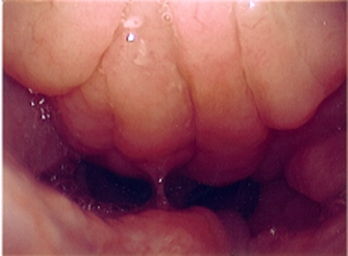Adenoids are part of the Waldeyer’s ring of lymphatic tissue including tonsils and adenoids. In young kids this is essential for achieving immune competence. However, as lymphoid tissue, it does react to URTIs, which are common in young children.
Adenoids themselves are physiological and will regress over time. They are usually at their most prominent around age 2 to 5 and regress by age 8 to 10. No treatment is required, and a large proportion of children can be managed with reassurance and ‘watchful waiting’.
Adenoids are located at the back of the nose, posterior to the choanae and can not be visualized without specialist equipment.
Nasal endoscopic view of adenoid pad:

Problems:
- Adenoid hypertrophy can lead to blockage of the eustachian tubes and Otitis Media Effusion (OME) with conductive hearing loss and/or recurrent infections. Speech delay can be a sign of hearing loss.
- In conjunction with large tonsils, it can lead to upper airway resistance syndrome and Obstructive Sleep Apnoea (OSA).
Most people have a degree of OSA at some stage in their lives. In children, indicators are heavy snoring with snort arousals or witnessed periods of apnoea, excessive daytime somnolence or hyperactivity and enuresis. OSA can also lead to faltering growth or obesity. Obesity can also lead to OSA.
- Recurrent tonsillitis.
Complaints (but not pathological):
- Hyponasal speech is not pathological, and intervention is not required.
- Some children will also present with snotty noses during this time of development. This does not require surgical intervention but can be managed medically if desired (salt water rinses; antihistamines or topical intranasal therapy if clinically suggestive of allergic rhinitis)
- Simple snoring is not a sign of OSA and does not require intervention.
C.M & G.T 24-04-23
Please see separate chapters on associated conditions including:
Refer to respiratory medicine if Obstructive Sleep Apnoea is suspected.













